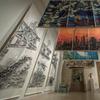Stimulating and Thought-Provoking Lectures To Be Held At The New York Ceramics & Glass Fair
- NEW YORK, New York
- /
- January 11, 2017
Augmenting the buzz surrounding The New York Ceramics & Glass Fair is its lecture series, held at the Bohemian National Hall during the run of the show. These stimulating lectures are being delivered by leading lights in the world of ceramics and glass, and the wide-ranging topics include the neurobiology behind the impulse to collect and the deaccession process of collectibles if “the kids don’t want it.” All of the lectures are free with show admission.
Thursday, January 19
12 Noon
Inside the Head of a Collector featuring Shirley M. Mueller.
Sigmund Freud described collecting “as a redirection of surplus libido onto an inanimate object.” Though Freud’s theory sounds intriguing, even titillating, it has little, if anything, to do with the real reasons collectors collect. The search for special objects is more basic. It is rooted in our neurobiology. As a serious collector of Chinese export porcelain and a physician board-certified in neurology and psychiatry, Shirley M. Mueller will explore these basic drives using concepts from the new science of neuro-economics, as well as her own experience and that of an earlier prominent collector, Eli Lilly. In this journey, she will demonstrate how understanding ourselves can help make us better collectors.
Mueller is a longtime member of the American Ceramic Circle and a passionate collector and scholar of Chinese export porcelain. Her exhibit, “The Luxury of Tea and Coffee,” recently closed after a five-year run at the Indianapolis Museum of Art. She lectures globally and publishes frequently about her subject.
2 p.m.
EUREKA! A Discovery of 18th-Century True Porcelain in Philadelphia and Other Tales of Ceramic Intrigue Robert Hunter, Editor, Ceramics in America, Chipstone Foundation.
The western world’s quest for the secrets of making porcelain is usually told as a Eurocentric tale recounting the romanticized exploits of alchemist Johan Frederick Bottger under the patronage of Augustus the Strong, elector of Saxony and King of Poland. However, beginning in the 1730s, the American South also became a hotbed of porcelain exploration, experimentation, and ultimately production. The search, however, for physical evidence of making true porcelain in 18th-century America has been frustratingly unsuccessful—until now. Revealed in public for the first time, a discovery of a porcelain punch bowl in Philadelphia’s archaeological context provides new evidence for the American Arcanum. The lecture will highlight the stories of an international cast of characters such as Andrew Duche, James Oglethorpe, William Cookworthy, Thomas Frye, Josiah Wedgwood and many other familiar names in the annals of American and English ceramics history.
4 p.m.
Pictures Worth a Thousand Pots: Tracing Ceramics in Art” Angelika Kuettner, Associate Registrar for Imaging and Assistant Curator of Ceramics, Colonial Williamsburg Foundation.
Whether used as a symbol to measure wealth and status, show everyday activity or serve as a prop in a still life, ceramics have been featured prominently in art throughout history. With a broad sweeping brush, this visually vibrant presentation will trace ceramics through art by taking a closer look at the role pottery and porcelain have played in paintings over time.
Friday, January 20
12 noon
The Feminine Clay Shannon Stratton, William and Mildred Lasdon, Chief Curator, Museum of Arts and Design.
Shannon Stratton will talk about the MAD exhibitions, “Coille Hooven: Tell It By Heart” and “Chris Antemann: Forbidden Fruit.” The lectures focuses on how women artists have incorporated women’s bodies as well as feminist content into ceramic-based practices.
2 p.m.
Just for Fun: Ceramics, Glass & Humor Leslie Grigsby, Senior Curator of Ceramics and Glass, Winterthur Museum.
Throughout history, most ceramics and glass served utilitarian purposes (storage, cooking and meal or beverage service) or were for ornamental use (flower containers, figures, etc.). Such objects reflected both the size of the owner’s pocketbook as well as his or her sense of place in the world. In contrast, other wares were created purely for their entertainment value. Many of these stood the test of time and—whether produced in costly or more affordable materials—suggest that humor continuously has permeated all levels of society.
Consider traditional “trick” or puzzle jugs, which spilled their contents on wealthy and less financially secure drinkers alike. Other vessels revealed surprising painted or three-dimensional imagery that slowly emerged as a beverage was consumed, and yet other items lampooned well-known political or military figures. Whether you ate off them, drank from them or simply played with them, these objects were made just for fun.
4 p.m.
Things of Beauty Growing: British Studio Pottery Glenn Adamson, Senior Scholar, Yale Center for British Art.
Curator Glenn Adamson will provide a sneak preview of the important upcoming exhibition “Things of Beauty Growing: British Studio Pottery.” The first major survey of its topic ever to be held in the U.S., the show tells the story of studio ceramics in Britain from the 1920s to the present through the evolution of the vessel form. The antiquity of the vessel and the familiarity of its shapes and forms have for more than a century provided British potters with a ready-made language to be invoked, emulated but also distanced, transformed and renewed. The exhibition traces the major typologies that have defined studio ceramics since the early 20th century. While varied, diverse, and original in their individual conception, the ceramic works assembled nevertheless share a common vocabulary. The exhibition will be shown at the Yale Center for British Art in New Haven in autumn 2017 and will travel to the Fitzwilliam Museum in Cambridge, England.
Saturday, January 21
12 Noon
Lighting in the 19th Century American Home Jeffrey Evans, President and Principal Auctioneer, Jeffrey S. Evans & Associates Inc. and Green Valley Auctions Inc. Decorative Arts Specialist, Fine Arts Appraiser and Independent Curator.
Today we take illumination for granted, but in the early 19th century only the wealthiest had the luxury of well-lit domestic spaces. This lecture will survey glass and ceramics lighting devices employing burning fluids, from whale oil to kerosene, and the significant changes this new technology brought to the average American life.
2 p.m.
Buy, Sell or Give? What Happens When the Kids Don’t Want it Leslie Ferrin, Director and Founder, Ferrin Contemporary, and Panelists Ulysses Grant Dietz, Daniel Farrell, Lark Mason and Martha Vida
“Buy, sell or give?” Leslie Ferrin, director at Ferrin Contemporary, specialists in ceramics since 1950, will present an illustrated introduction aimed at demystifying the deaccession process for both artists and collectors who fear what might happen to their collections if “the kids don’t want it.” For the generation who are lightening their load, there is a clear benefit to buyers and institutions who can now edit and build important collections of late 20th- and early 21st-century studio craft and design. Following the presentation, Ferrin will introduce the Craft Legacy Project, a long-term national program, and will be joined by curators and art professionals for a question-and-answer period.
Panelists:
Martha Vida, Founding Director, The Marks Project
Daniel Farrell, Fine Art Appraiser and Consulting Producer of The Antiques Road Show
Ulysses Grant Dietz, Chief Curator, Newark Museum
Lark Mason, iGavel Auctions and Lark Mason Associates
4 p.m.
What A Long, Strange Trip It’s Been: American Ceramics from Functional to Funk Jeannine Falino, Independent Curator.
There’s no question that since midcentury, contemporary ceramics have advanced the direction of American craft. Independent curator Jeannine Falino will discuss the early movers-and-shakers who jumpstarted a generation of artists and in so doing, changed the way craft was perceived, made and used. Her lecture will include early rebellions within the functional core of the field that led to funk ceramics, and its impact on the field to the present.
The New York Ceramics & Glass Fair, which takes place on the fourth and fifth floors of the Bohemian National Hall, 321 East 73rd Street (between First and Second Avenues), opens with a Private Preview on Wednesday, January 18, from 5:00 p.m. to 8:30 p.m., and to the public on Thursday, January 19 through Sunday, January 22. Hours are 11 a.m. to 7 p.m., Thursday through Saturday, and on Sunday from 11 a.m. to 4 p.m. Tickets are $20 per person and can be used throughout the duration of the fair.
An important component to the New York Ceramics & Glass Fair is their extensive lecture program, which runs throughout the duration of the fair. With a line-up of distinguished curators and experts, this year’s series will not disappoint collectors and connoisseurs of all stripes.
The New York Ceramics & Glass Fair is co-produced by Meg Wendy of MCG Events LLC and Liz Lees, of Caskey Lees Inc.
For more information visit, www.nyceramicsandglass.com or phone 929-265-2850.










![Peter Paul Rubens (Flemish, 1577–1640), After Titian (Tiziano Vecelli) (Italian [Venetian], c. 1488–1576), Rape of Europa, 1628–29. Oil on canvas, 71 7/8 x 79 3/8 in. Peter Paul Rubens (Flemish, 1577–1640), After Titian (Tiziano Vecelli) (Italian [Venetian], c. 1488–1576), Rape of Europa, 1628–29. Oil on canvas, 71 7/8 x 79 3/8 in.](/images/c/e2/2e/Jan20_Rape_of_Europa100x100_c.jpg)





